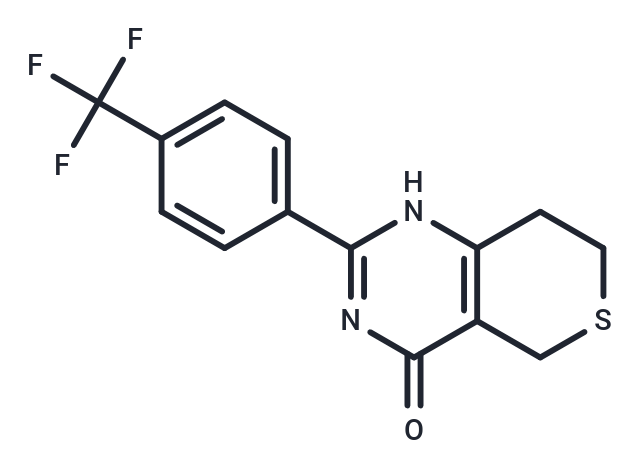Shopping Cart
- Remove All
 Your shopping cart is currently empty
Your shopping cart is currently empty

XAV-939 (NVP-XAV939) is a Tankyrase (TNKS) inhibitor that inhibits TNKS1 and TNKS2 (IC50=11/4 nM). XAV-939 selectively inhibits Wnt/β-catenin-mediated transcription.

| Pack Size | Price | Availability | Quantity |
|---|---|---|---|
| 5 mg | $48 | In Stock | |
| 10 mg | $59 | In Stock | |
| 25 mg | $111 | In Stock | |
| 50 mg | $179 | In Stock | |
| 100 mg | $276 | In Stock | |
| 200 mg | $490 | In Stock | |
| 1 mL x 10 mM (in DMSO) | $54 | In Stock |
| Description | XAV-939 (NVP-XAV939) is a Tankyrase (TNKS) inhibitor that inhibits TNKS1 and TNKS2 (IC50=11/4 nM). XAV-939 selectively inhibits Wnt/β-catenin-mediated transcription. |
| Targets&IC50 | TNKS1:11 nM (cell free), TNKS2:4 nM (cell free) |
| In vitro | METHODS: Human colorectal cancer cells SW480 were treated with XAV-939 (1 µM) for 16 h. The expression levels of target proteins were detected by Western Blot. RESULTS: XAV-939 decreased the abundance of β-catenin and increased the abundance of axin and p-β-catenin in SW480 cells. [1] METHODS: Normal human epidermal keratinocytes NHEK were treated with XAV-939 (10-50 µM) and rhIL-6 (50 ng/mL) for 24 h, and the number of target cells was detected by APC BrdU flow kit. RESULTS: XAV-939 largely inhibited the over-proliferation of NHEK. [2] |
| In vivo | METHODS: To investigate the in vivo function of Wnt signaling, XAV-939 (1 mg/mL, 100 μL, 10% DMSO/90% 0.9% NaCl) was administered intraperitoneally to an IMQ-induced psoriasis mouse model once daily for seven days. RESULTS: Administration of XAV-939 resulted in a significant reduction of IMQ-induced epidermal hyperplasia and dermal inflammatory infiltration in mice. XAV-939 administration significantly reduced the infiltration of F4/80+ macrophages and CD3+ T cells in IMQ-induced inflammatory dermal lesions.Wnt signaling is critical for IMQ-mediated epidermal hyperplasia. [2] METHODS: To assay antitumor activity in vivo, paclitaxel (10 mg/kg) and XAV-939 (10 mg/kg) were injected intraperitoneally twice weekly for four weeks into BALB/c nude mice harboring human mammary carcinoma tumor MDA-MB-231. RESULTS: The combination of paclitaxel and XAV-939 effectively inhibited the growth of mammary tumors compared with control and each single treatment. [3] |
| Cell Research | XAV939, the recently identified small molecule shown to specifically inhibit PARP activity of tankyrase 1 (and tankyrase 2 at higher concentrations), was used here at much lower concentrations than 3-AB. The tankyrase specific inhibitor XAV939 was solubilized in DMSO at 55°C to a stock concentration of 10mM, which was diluted to a working concentration of 100μM; final concentrations of 0.5μM or 1μM were well within the concentration parameters suggested for cell culture experiments to inhibit tankyrase specifically. Cultures were maintained under these conditions for the duration of the designated time course. Controls were exposed to DMSO alone. Following treatment, cells were lysed and prepared for western blot analysis. Tankyrase 1 and DNA-PKcs protein levels were normalized to the β-actin loading controls and quantified [1]. |
| Animal Research | XAV-939, a selective inhibitor of tankyrase (TNKS)-1 and TNKS-2, was injected i.p., at a dose of 1 mg/ml, once a day for seven consecutive days of IMQ treatment (injection volume 100 μl). Control mice were injected with 100 μl 10% DMSO/90% 0.9% NaCl, the solvent for XAV-939 [3]. |
| Alias | XAV939, NVP-XAV939 |
| Molecular Weight | 312.31 |
| Formula | C14H11F3N2OS |
| Cas No. | 284028-89-3 |
| Smiles | FC(F)(F)C1=CC=C(C=C1)C1=NC(=O)C2=C(CCSC2)N1 |
| Relative Density. | 1.5 g/cm3 |
| Storage | Powder: -20°C for 3 years | In solvent: -80°C for 1 year | Shipping with blue ice. | ||||||||||||||||||||
| Solubility Information | 10% DMSO+40% PEG300+5% Tween 80+45% Saline: 1.25 mg/mL (4 mM), suspension.In vivo: Please add the solvents sequentially, clarifying the solution as much as possible before adding the next one. Dissolve by heating and/or sonication if necessary. Working solution is recommended to be prepared and used immediately. DMSO: 12.5 mg/mL (40.02 mM), Sonication is recommended. | ||||||||||||||||||||
Solution Preparation Table | |||||||||||||||||||||
DMSO
| |||||||||||||||||||||

Copyright © 2015-2025 TargetMol Chemicals Inc. All Rights Reserved.